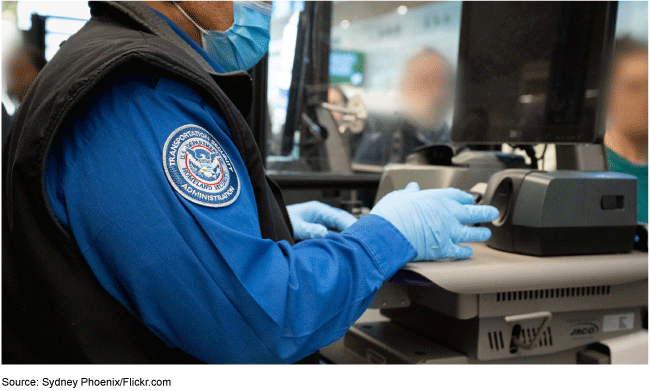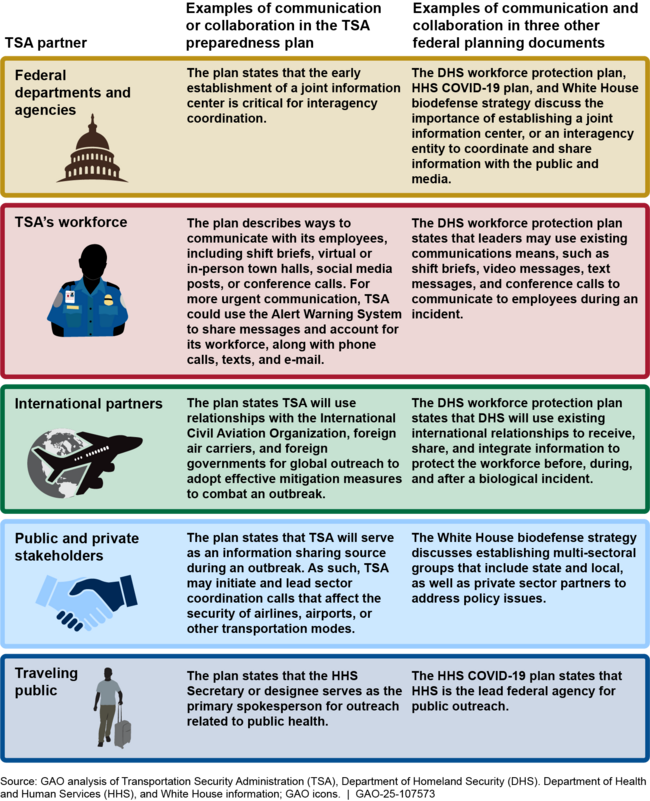Communicable Diseases: Transportation Security Administration Developed Its Required Preparedness Plan
Fast Facts
COVID-19 led to over a million deaths in the U.S. and disrupted travel. TSA is the primary federal agency responsible for securing our transportation systems. This Q&A looks at TSA's preparedness plan for another potential communicable disease outbreak.
We found that TSA:
Coordinated with other agencies to help ensure its plan aligned with existing federal plans
Eventually distributed its plan to federal agencies, its workforce, the public, and other partners—after we asked about it during our review
Took steps to implement the plan, including updating airport guidance

Highlights
What GAO Found
In February 2024, the Transportation Security Administration (TSA) published the Transportation Security Preparedness Plan to Address the Event of a Communicable Disease (TSA preparedness plan), as required by the National Defense Authorization Act for Fiscal Year 2022 (FY 2022 NDAA). The purpose of the plan is to support the protection of the transportation security sector's workforce and maintain essential functions and services. It builds on several planning documents that the agency previously developed to prepare for a communicable disease outbreak. These include the Chemical/Biological and Pandemic Base Plan, TSA's primary plan to prepare for and respond to various health incidents, according to TSA officials.
To align its preparedness plan with other federal plans and strategies, TSA reviewed documents, spoke with officials at several federal agencies, and requested feedback from these agencies on a draft of the TSA preparedness plan. According to TSA documents and officials, the agency reviewed approximately 80 documents, including related plans from other federal agencies.
GAO also identified examples of how plans to communicate and collaborate in the TSA preparedness plan aligned with similar steps in three federal planning documents. These include plans from the Departments of Homeland Security and Health and Human Services as well as the White House's National Biodefense Strategy (national biodefense strategy), as shown in the figure below.
Examples of Alignment Between the TSA Preparedness Plan and Three Federal Planning Documents

Note: To determine alignment, we reviewed the portions of TSA's plan that relate to communicating and collaborating with the five types of partners required by statute. For more details, see Fig. 3 in GAO-25-107573.
The FY 2022 NDAA also required TSA to distribute the TSA preparedness plan to certain partners, including federal departments and agencies, TSA's workforce, and the traveling public. TSA initially did not distribute the plan to all partners identified in the statute. However, in December 2024, TSA acknowledged this oversight in response to GAO's questions and subsequently distributed the plan to all partners.
TSA has taken steps to implement the TSA preparedness plan. For example, TSA updated field office planning guidance to include elements of the plan and intends to conduct exercises by the end of 2025, according to officials.
Why GAO Did This Study
Global connectivity through air and other modes of transportation have facilitated convenient international travel, but also risks speeding up the spread of emerging communicable diseases, such as COVID-19, which led to over a million deaths in the U.S. and cost trillions of dollars. TSA is the primary federal agency with the mission of securing the nation's transportation systems, including air travels. During communicable disease outbreaks, TSA is to also minimize disruptions across these modes of transportation.
The FY 2022 NDAA includes a provision for GAO to assess the TSA preparedness plan. This report provides information on the plan, including the extent to which it aligns with other federal plans and strategies and TSA's efforts to distribute and implement the plan. To conduct this work, GAO reviewed TSA documents and compared the TSA preparedness plan to three other federal planning documents, including the White House's National Biodefense Strategy. GAO also interviewed TSA officials from its headquarters and obtained information from TSA field components at four selected airports.
For more information, contact Tina Won Sherman at shermant@gao.gov.
